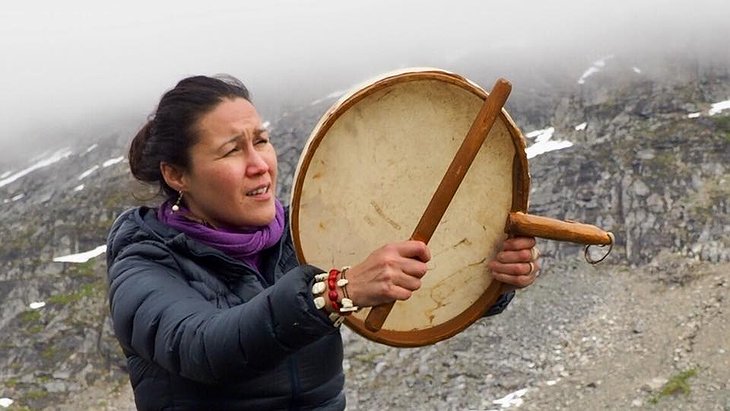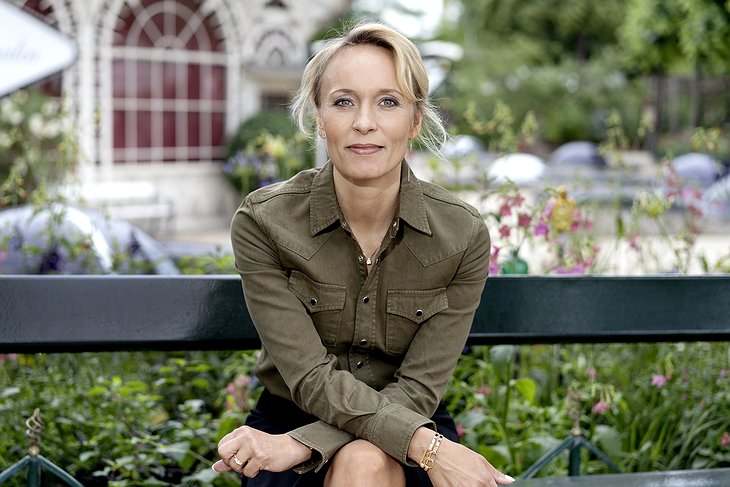When the Greenlandic musician, Varna Marianne Nielsen, saw a photograph of herself on a poster advertising the annual Greenland fair in the amusement park Tivoli in Copenhagen at the end July she became shocked. She was not a participant in the fair as an artist - the last time she performed in the fair was thirteen years ago - and no one had asked her for permission to use the photograph of her.
In an interview with Stundin Varna, who is known drumdancer in Greenland and abroad, says that the taste in her mouth regarding the publication of the photo soured significantly when she contacted the Tivoli and asked its public relations department why the photograph was published. "... I got the reply from from Tivoli that I just looked so Greenlandic and that fit the event that they were advertising perfectly. [...] They basically said: You are so Greenlandic. They really nailed it in their reply to me and then I knew that this was how they choose this photo. It is 2021 and we are still being treated like some exotic objects."
Greenland is an autonomous territory part of within the Kingdom of Denmark and thus is not an independent nation. Greenland is the last remaining Danish "colony" along with the Faroe Island. In the beginning of the 20th-century Denmark also ruled Iceland and had colonies in the West-Indies.

Tivoli kept on using the photo
She contacted the Tivoli on the 29th of July, two days before the fair started, and expressed here criticisms. But even though she did this the Tivoli still continued to use the poster with her photograph on it to advertise the fair. "They kept on using the photograph of me on its poster. They did not say we are sorry, we are sorry and removed th photo amd found another one but kept on showing the same poster. I sometimes think that people think that we Greenlanders should just shut our mouths and be happy that we are getting attention and don´t make a fuss. Shut up and be pleased that you can be of use to someone," Varna says.
"The Tivoli would never use a photograph of a known Danish musician to advertise an event because that person look so Danish."
Held to celebrate the culture of Greenland
The Greenland Fair is held in the Tivoli in Copenhagen every year and has been since 2002.
The objective of the fair is to "spread out Greenlandic culture, music, dance, theater, movies, fashion and food" as it says on the homepage of the Greenland fair. During the fair its guests can also buy various artifacts and objects from Greenland, products made of sealskin, Greenlandic jewellery and design.
Varna says that the fair is like festive national day for those Greenlanders who reside there.
Varna is a known musician in her home country and has performed in concerts in other countries through the years, like in Denmark and Iceland. Among other things she participated in a concert in the music hall Harpa in Reykjavík in 2018 where Iceland´s sovereignty from Denmark in 1918 was commemorated.
Varna: Tivoli would not do this to a Danish artist
Varna says that the Tivoli in Copenhagen would never do a similar thing to Danish artist: Publish a photo of her or him without asking the individual for permission and then reason that this was done because the artist looked so Danish. ,,I am also a human being. The Tivoli would never use a photograph of a known Danish musician to advertise an event because that person look so Danish. I am a specific artist, who does specific artwork and I come from a specific cultural area."
She says that her interpretation of what happened is that according to Danes it seems that Greenlanders are just objects on posters. "It seems that we Greenlanders are just like some objects on posters in the minds of the Danes."

The Tivoli says it´s sorry
In a written answer via e-mail Tivoli´s press officier, Torben Plank, says that the Tivoli is sorry for having published the photograph of Varna: "We are very sorry about this matter where we believe we acted in good faith. We received the image in question from Visit Greenland, who made it clear that we could use it on posters etc. [...] We responded to Varna's request and apologized for any inconvenience she may have experienced due to the use of the image. When we became aware of the objections from Varna, Greenland In Tivoli had already begun, and the posters were up. We are very sorry that the picture of Varna was used on the poster. We have removed all the images and have asked Visit Greenland to double-check the pictures they provide in the future," Plank says.
"We are very proud of Greenland in Tivoli, which is Greenland's biggest cultural event outside Greenland."
Furthermore Torben Plank says that the Tivoli is very proud of the Greenland fair and that it brings Greenlanders and Danes together in a positive way. "We are very proud of Greenland in Tivoli, which is Greenland's biggest cultural event outside Greenland. It is one of our most cherished events that brings Greenlanders and Danes together in the best way."
Remnants of a troubled, racist past?
Varna´s case calls to mind historical examples about Denmark´s relationsship to its "colonies" and specifically to Greenland and the islands in the West Indies. Greenlandic cultural fairs have been held in Denmark ever since the 19th century and similars fairs about Iceland were also held.
One such cultural fair about the colonies of Denmark (Greenland, Iceland, Faroe Islands and the Danish islands in the West Indies) was held in 1905 to finance the work of the Danish Home Craft Organization (Dansk Kunstflidforening). Objects like clothing and artwork from the Danish colonies were sold in the fair to this end.
When it beacme known that Iceland was to be portrayed as a Danish colony alongside Greenland and the islands in the West Indies some Icelandic students in Copenhagen, which was Iceland´s capital at the time, became furious.
One of them, Vilhjálmur Finsen, wrote a scathing article in a Danish newspaper condemning this. "Can Iceland be known to participate in an exhibition like this, were Icelandi national costumes are shown next to eskimoes and negro women? Here I say no! It is a disgrace for our nationality and gross undervaluation of our culture, and its impossible to interpret this in any other way. What would the Danes, who are a civilized nation, do if for example the United States would exhibit them next to savages in order to make money out of it?"
The debate about Iceland´s role in exhibition led to the conclusion that its name was changed to "Dansk koloniustilling samt udstilling fra Island og Færöerne“ or "An exhibition from the Danish colonies as well as an exhibition from Iceland and the Faroe Islands".
Iceland had at this time, and during the preceding decades, been fighting for more self-ruling from Denmark; a fight which led to Iceland´s sovereignty from Denmark in 1918. Iceland and the Faroe Islands where then, in the end, separated from Greenland and the West-Indies in exhibition, two areas which the Icelandic students had refered to in a derrogatory, racist way in the debate.
In the exhibition, which was also held in the Tivoli in Copenhagen like the Greenland fair nowadays, a replica of an old Icelandic manuscript was shown as well as paintings showning Icelandic nature. From the colonies in the West Indies the siblings Alberta and Victor were brought to Copenhagen and shown to the guests of the exhibition in a cage.
During these years, around the turn of the 19th and 20th century, such exhibitions of people of other races, and people and cultures from faraway places, were relatively common in the predominantly, ethnically white-skinned northern and western Europe.
In the world fair in Paris in the year 1900, five years prior to the exhibition in the Tivoli in Copenhagen, there was for example a special exhibition about African-Americans ("The Exhibit of American Negroes"). The purpose of that exhibition was to show and underline the progress that African-Americans had, despite slavery and centuries of racism and discrimination, made in the society in United States. In the exhibition the guests of the World Fair could, among other things, take a look at the 400 patents for various innovatie things that African-Americans owned and that time.
The exhibition in the Tivoli about the Danish colonies as well as Iceland and the Faroe Islands in 1905 was then in many ways a child of its time.
















































Athugasemdir